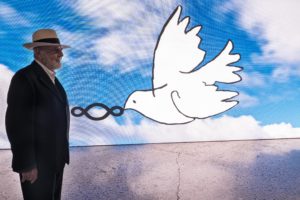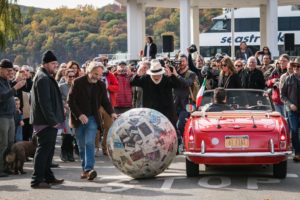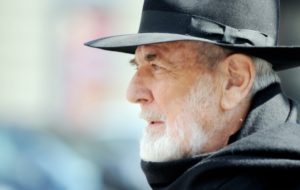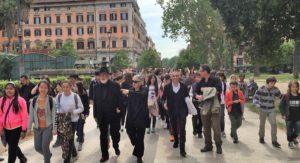Si vis pacem, para bellum, Socrates. Preventive War, Bush and Blair. Over two thousand years of history, yet sadly no anachronism. Concepts that remain globally relevant, differing only in nuances. Then, there are those who are dismantling these paradigms: Michelangelo Pistoletto. He turns them upside down, without appeal. The master, in a collective and empowering invitation, presents us with the only possible solution: Preventive Peace. But it is his entire artistic practice and poetics, from the very beginning, that have been oriented towards a transformation of society in a responsible sense. In short, the art of the master and Cittadellarte have always embraced the culture of peace.
This life-long commitment will receive a recognition of absolute prestige and authority: this evening, Friday, February 21, during an event¹ at the Alberoni Gallery in Piacenza, it will be announced that Michelangelo Pistoletto is among the nominees for the 2025 Nobel Peace Prize². The nomination, presented by the Gorbachev Foundation Association³ and supported by Nobel Italia, has been accepted by the Norwegian Nobel Committee in Oslo and is based on Pistoletto’s commitment to using art as a fundamental tool for achieving Preventive and lasting Peace, through which he urges us to act today to avoid future conflicts.

For the master, it is crucial to promote a change in thinking and behavior on a global level, encouraging and guiding society to live in harmony, not only among humans, but also with the environment and all forms of life. In this regard, his Third Paradise is a symbol that represents the harmonious synthesis between all differing and opposing elements. For decades, the master has applied this principle not only to art but to life itself, urging recognition that every opposition —between man and nature, between the individual and society, between tradition and innovation — can become an opportunity, ultimately overcoming divisions and acknowledging the interconnectedness of all elements, even those most extreme and opposed to each other. In this sense, his is a radical appeal to peace.
For Pistoletto, spirituality is also understood as a unifying force, capable of transcending differences and creating a sense of universal belonging, of which art becomes the common language of a reconciled humanity.
Michelangelo Pistoletto’s nomination for the 2025 Nobel Peace Prize is, therefore, a recognition not only of his artistic talent but also, and above all, of the awareness-raising work and commitment the artist has dedicated and continues to dedicate to building a fairer, more inclusive, and peaceful world. Through his work, the founder of Cittadellarte has shown how art can be a powerful means of change and participation, capable of educating new generations to live in a world of peace and to act preventively with a deep sense of responsibility. This nomination, in addition to being an award to Michelangelo Pistoletto, is therefore a strong signal that art, culture, and creativity are essential in building lasting peace, going beyond present crises and laying the foundations for a better future for all.
Michelangelo, let’s relive the moment when you learned you were among the nominees for the Nobel Peace Prize. What did you feel at that instant? What was your reaction?
I felt a sense of hope: the desire is that all the artistic work I have produced personally and through Cittadellarte may increasingly contribute to the realization of an art that takes on the commitment to activate all the sectors that make up the fabric of society, transforming it and bringing it to a new phase.
Let’s analyze the news from a broader perspective. An artist nominated for the Nobel Peace Prize: what socio-cultural impact can this nomination have?
This nomination creates an opening for listening, it’s already a result, because it opens up the possibility of accelerating proposed changes. It will be easier to spread the formula of creation so that it can be shared and lead to what it aims for, namely peace. Thus, it opens up a possibility for the diffusion of the principle of peace, which consists precisely in this formula. Creation stems from art, and the fact that art can take on the responsibility it deserves through this nomination is very important to me. I see the nomination for the Nobel Peace Prize not just as a personal recognition for what I have done so far, but as a commitment to future work.

Photo by Alexa Hoyer.
From the global dramaticity of war to the daily social contrasts, what is the relationship between the human being and conflict?
Conflict is inevitable. This is evident in the trinary formula, where the two elements contained in the outer circles always find in the central one the point of convergence to produce a new element in duality that didn’t exist before. So there is confrontation, impact, a powerful emergence that continuously produces change in nature, just as a cosmic extension. Nature does not make judgments or ethical evaluations of itself; it proceeds instinctively, just like the behavior of animals. Humans, however, have developed the artificial dimension that allows them to pass judgment, to reflect on what is happening as a result of the encounter between the elements. So, in the intellectual, spiritual, and behavioral dimension, humans can give meaning to what they are producing. The animal, part of the physical existence, feeds on any material necessary for physical survival, but humans have also started to nourish themselves with an intangible intellectual substance: thought. The physical universe, through human beings, also assumes a metaphysical dimension, a universal territory developed to the point that today we have created artificial intelligence, which is a true cultural universe of which we are the authors and responsible.
Michelangelo, let’s move to an icon of peace from the late 1800s and early 1900s: Mahatma Gandhi. The Indian politician — who never won the Nobel despite five nominations — is known for his subversive work, promoting and inspiring acts of civil disobedience and nonviolent protest. How does his philosophy relate to or differ from yours?
There is a difference between Gandhi’s position and the one I propose with the creation formula and the Third Paradise, although both have a critical view of what happens in the world. Personally, I believe that neither criticism, nor claims, nor protest can be the key to generating change. For me, everything must be based on the proposal. So, I don’t even have the concept of sacrifice to which Gandhi dedicated himself, while for me, the proposal is found in the simplest and most inevitable qualities that already exist in everyone’s life. Therefore, we must uncover, bring out, and develop this beneficial quality that is inherent in every person. We must still face the world today, which is different from Gandhi’s time.

Photo by Pierluigi Di Pietro.
There are over 50 active armed conflicts in the world: global peace still seems very distant, on the verge of being an utopian slogan. According to your vision, is a change of course possible, or is an apocalyptic decline now inevitable? What is, in this sense, the role of art?
Being optimistic is not easy. Creative capacity and artificial construction extended to a planetary and interplanetary dimension can decisively accelerate the end of the human era. It is therefore necessary to dedicate all our efforts to extending our life on the planet, even reaching knowledge still unimaginable today through science and technology, thus avoiding that our competitive capacity leads to destruction. Art must take on a propulsive role for radical change, bringing about a shared, responsible concept of humanity and a peaceful self-certification of intelligence. I don’t know if we will reach peace, but just working towards it makes me feel better.
What are the risks that can characterize this process?
Human power has reached a point where our capacity for judgment can be both constructive and destructive. My appeal, therefore, is to live and compete not to destroy, but to build a collective consciousness of what humanity can and will be if it overcomes cultural cannibalism. If humans orient themselves towards mutual respect, they will have the ability to find balance and harmony for all existence.
Not only that: the risk is that the human lion, having become Narcissus, falls in love with his power, his predatory technique, and his omnipotent image, to the point of drowning in the sea of his own reflection. In my art, I have used the mirror as a vision of a responsibility extended to all of humanity: the development of society happens in front of a mirror, in which we not only do not drown, but see the extension of the universe of which we are all part and in which we want to continue to live. The reflective frame thus becomes the mirror of survival. In this way, somehow, we can feel immortal while we are alive.
On the Treccani Encyclopedia, peace is described as “the condition of normal relations, the absence of wars and conflicts, both within a people, a state, or organized, ethnic, social, religious groups, and externally, with other peoples, other states, other groups.” What could be your definition of peace?
The word ‘peace’ for me means not having as its goal the instinctive nourishment of the animal, which translates into the possessive culture of humans trying to feed culturally and also physically by suppressing their peers. With the word ‘peace,’ I therefore mean a true refoundation of thought. Thought has always been the noble reference in the history of humanity, from politics to religion to art, which today unfolds all its power without being subjected to any form of predatory domination.

Let’s take a look at the future of the new generations. How do you teach peace to a child?
Teachers must be able to put into practice the concept of dynamic balance and harmony brought by the symbol of the Third Paradise. It is necessary to create a new cultural awareness that starts primarily with educators. The family is also important because the culture of peace extends from adults through conscious connection. There is always duality: two elements, when compared, will produce an effect that will determine new decisions.
There are countless socially engaged art projects in which the Pistoletto Foundation has been involved. What is, in summary, your and Cittadellarte’s contribution to peace?
For us, the culture of peace is present in all artistic activities — always in relation to all areas of social life — that I have personally developed, from the Mirror Paintings to the experience at the Academy of Vienna and the birth of Cittadellarte. It is not necessary to use the word ‘peace’ in every project, but to act in such a way that peace is truly realized, working towards a constant peaceful progress, globally extended through every area of the social fabric.

